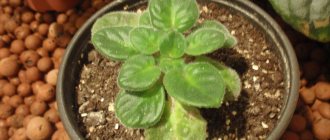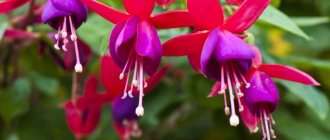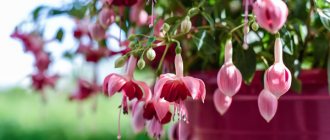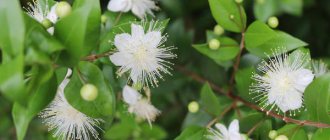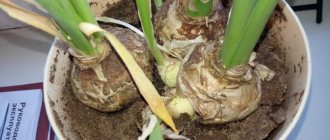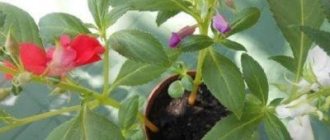Fuchsia - planting, care, feeding
Fuchsia is one of the most common indoor plants. Experienced gardeners use ampelous fuchsia to decorate garden areas, gazebos, and recreation areas. In addition to the ampelous one, there are many hybrid varieties of this plant. Caring for them is almost the same, but you should remember that in order to form a strong standard tree or shrub, you must follow some rules.
Planting fuchsias
The basis of a good plant is choosing the right soil for planting. For fuchsias, the preferred mixture consists of equal parts of peat, turf soil and sand. For good drainage, it is necessary to lay the bottom of the flowerpot with expanded clay or pebbles. The soil should be loose and well breathable. Air circulation near the root system helps supply oxygen, an important substance for fuchsias.
However, the soil should fit snugly against the sides of the pot and support the plant well. You should also know that a big pot is not always good. In the case of fuchsia, it is recommended to gradually increase its size, thereby allowing the root system to gradually entwine the earthen ball. It is advisable to replant the plant in the spring.
Watering fuchsias
Watering the plant requires special attention and precision. Fuchsia loves abundant watering . That is why it is preferable to choose a pot for fuchsia with drainage holes inside so that the water does not stagnate and lead to root rot. Since fuchsia prefers warm places for flowering, rapid evaporation of moisture should be taken into account. To prevent drooping foliage, fuchsia should be sprayed with water from time to time. If the foliage is drooping, it may be not only a lack of moisture, but also root rot. If after several sprayings the plant does not “come to life”, it is necessary to check the root system, since excessive watering can aggravate everything. Also, leaf drop may be due to lack of light.
| Fertilizer Blooming Flower happiness 250ml Buy | Soil Flower Happiness® For flowering plants Universal Buy | Fertilizer Stimulating flowering Flower happiness Buy |
In summer, it is advisable to keep the plant outdoors. Fuchsia loves light, but exposing it to direct sunlight is undesirable. Also, do not place it on the north side. Drafts and dampness affect flowering, slowing it down.
How to feed fuchsia
For normal growth and development, many plants require fertilizing. Organic and mineral fertilizers help improve growth, long-term flowering, and increase resistance to harmful substances and parasites. In the composition of such fertilizers for fuchsias, very useful elements are: boron, selenium, iron, zinc. There are two types of feeding: root and foliar. Root feeding involves getting fertilizer into the soil and absorbing the substances by the roots. When foliar fertilizer is applied, the undersides of the leaves are sprayed. Fuchsias are very demanding and too little or too much nutrients can have a negative impact on the plant. If you have just planted or transplanted it, the plant should be left alone for 3 weeks. Sick plants and young cuttings only suffer from feeding, so they do not need it at all. After the fuchsia has taken root, it is necessary to draw up a fertilization schedule. It is advisable to apply it with each watering 3 to 5 times a week. In this case, the soil should not be too dry or waterlogged. For young fuchsias, fertilizing with a high nitrogen content is especially useful. For older and stronger plants, the concentration of phosphorus and potassium in fertilizers is increased.
Wintering fuchsia
After the flowering season, the fuchsia foliage falls off and the wintering period begins. The plant is brought into the house from the street when the air temperature drops to 5-7 degrees Celsius. During the dormant period, fuchsias prefer to be in cool places. Lighting becomes less important for them, but its absence leads to the fact that the plant becomes too elongated, but the shoots do not have sufficient strength for further development. High air humidity negatively affects the plant in winter. Fuchsia turns yellow and may die due to rotting of the root system. Consequently, the plant overwinters best closer to the window, but further from the radiator or other heat sources.
If you follow simple care instructions, your fuchsia will delight the eye with abundant flowering and play of colors for many years!
Possible problems
Fuchsia reacts extremely negatively to stagnant air, so during the growing season the room where the flower is located must be systematically ventilated, or the pot with the plant can be moved to the balcony.
Fuchsia fades quickly
There are several reasons why the bush fades relatively quickly:
- if in winter the bush was watered abundantly and it was warm;
- if during the spring-summer period the lighting was excessively poor;
- if the bush was fed and watered less often than necessary in the summer.
Fuchsia leaves are falling
If the foliage flies away in winter, then the bush must be removed from bright light, while the developing buds must be pinched. Flying leaves can also be associated with excessively poor watering, too low air humidity and very high temperatures. Fuchsia can drop its buds if there is excessively poor lighting, untimely watering and very high air temperatures.
Spots on fuchsia leaves
The bush becomes affected by spotting if it is watered too often in winter.
Fuchsia has dropped its buds
During the period of bud formation and flowering, it is forbidden to disturb the bush, since if it is rearranged or rotated, then all its buds will fly off. If a flower is exposed to a draft, its buds will also fall off.
Harmful insects
Most often, spider mites and whiteflies settle on such a plant.
For beginners about fuchsias
How to make fuchsia bloom profusely
To create a beautiful shrub, a crown is formed by pinching. In February, it is transplanted by transferring from a small pot to a larger one just a couple of centimeters. Fuchsia will build up its root system and spend less energy on flowers.
Since the shoots of the plant have grown over the winter, the central stem and several branches are selected to form a crown and pinched at the required height. After a few weeks, the fuchsia will be covered in flowers.
Important! Excess shoots can be placed in water until roots appear, and then planted.
The plant needs constant feeding, this is especially important during the flowering period. How to feed fuchsia for abundant flowering? From spring to autumn, feeding (root and foliar) is carried out every week. The sheet is treated with plantofol in combination with zircon and epin. This will prevent the buds from falling off and will affect the abundance of flowering.
Applying fertilizer to the soil
How to make fuchsia bloom profusely
Flowering largely depends on the composition of the soil, what fertilizers are applied (dry or liquid) and fertilizers (mineral or organic). You can purchase ready-made soil at the store or prepare it yourself. The soil is suitable from a mixture of coconut fiber and any universal soil with the addition of vermicompost for softness and looseness.
Regardless of where you purchased the soil, it should definitely be calcined at high temperatures to destroy all microorganisms, disease spores, and weed seeds. Or this can be done by strong cooling: the soil is moistened with water, taken out to a frost not lower than −10°C and left for several days. Freezing destroys all pests, but, unfortunately, beneficial bacteria too. Such procedures are carried out 2-3 times, then the soil is watered with biological products, for example, phytosporin, which contains microorganisms. In this state, the soil is left in a bag for 2 weeks.
Fertilizers for fuchsia are selected depending on the growth phase:
- young specimens need fertilizing with a high nitrogen content to increase green mass and the growth of young shoots;
- to make fuchsia cover itself with abundant flowers, you need to add fertilizers that include phosphorus and potassium;
- when treating the bud with the drug, the color turns out bright and saturated;
- It is good to alternate watering flowers with mineral and organic compounds.
When and how often should nutrients be added?
Anthurium is a flower that requires regular replenishment of micronutrients. Fertilizers need to be applied both in the spring and summer, and in the fall. The frequency of procedures is every two weeks.
But not everyone knows how to fertilize anthurium at home in order to make it bloom as long as possible. In winter, the plant is fed no more than once a month, since it is in a dormant state.
For information! Particular attention should be paid to young plants; fertilizers are applied every two weeks for the first 6 months. Fertilizing is carried out regardless of the season. Fertilizer for anthurium should contain a whole range of useful microelements, given its luxurious large leaves and incredibly beautiful inflorescences
It is introduced only when the flower is completely healthy. If pests or signs of specific diseases were discovered, then first of all, you need to get rid of them, and then apply fertilizers
Fertilizer for anthurium should contain a whole range of useful microelements, given its luxurious large leaves and incredibly beautiful inflorescences. It is introduced only when the flower is completely healthy. If pests and signs of specific diseases were discovered, then first of all, you need to get rid of them, and then apply fertilizers.
Fuchsia - plant care at home
Homeland: tropics of South and Central America, New Zealand.
Evergreen shrub. Currently, more than 8,000 varieties are cultivated in the world.
Fuchsia is an unpretentious indoor plant, with only one whim - after the start of flowering it cannot be rotated or rearranged.
It is grown as a beautiful flowering plant. Blooms profusely. Fuchsia flowers come in different colors, simple and double. The flower itself consists of two parts: a corolla-shaped bright calyx and a tubular corolla with bent leaves. The petals are shorter than the calyx lobes, the stamens are longer than the calyx. After flowering, a fruit is formed.
Illumination: bright diffused light.
Temperature. Optimal temperature:
- in winter (5-10)°C;
- in summer (18-25)°C. Temperatures above 25°C begin to depress the plant. In summer, it is possible and beneficial to take fuchsia outside.
Watering. Frequency of watering - with light drying of the earthen clod. During the growing season, watering is usually daily. By winter, we gradually reduce it.
The soil. Composition of the soil mixture:
1st option: 1 part leaf soil + 1 part turf soil + 1 part peat + 1 part humus + 1 part sand;
2nd option: 1 part leaf soil + 1 part turf soil + 1 part sand.
The mixture must be sterilized before use.
Fertilizer
During the growing season (March - October), the frequency of fertilizing is once a week with complex fertilizer for indoor flowers, with a high potassium content. Content N: P: K = 20: 20: 20. Feeding is stopped when the plant stops its growth and becomes lignified. These symptoms indicate that fuchsia is entering a dormant state. After winter dormancy, the first fertilizing is carried out when the young stems grow 2-3cm.
Bloom
The flowering season is from spring to autumn.
When the flowers fade, they begin to dry out, forming fruits with seeds. If the fruit is not removed in a timely manner, it will draw the energy of the plant’s development onto itself, which will be detrimental to further flowering. To obtain long-term abundant flowering, faded flowers must be removed immediately.
Flowers on the plant form only on young shoots. The more young stems, the more flowers we will get. To increase the number of young shoots, pinch the growing point.
Remember that fuchsias reach their peak flowering 12 weeks after the last shoots are pinched. Taking this into account, the last pinching should be completed in mid-April.
Fuchsia transplant. It is carried out in mid-March and combined with pruning.
Why does it drop buds and leaves?
Fuchsia sheds its leaves and buds for several reasons. This mainly happens due to improper care.
Incorrect lighting
Lack of lighting causes the shoots to turn pale and elongate. Fuchsia becomes weak and loses its ability to bloom. The leaf blades grow small, wither, and the buds do not open.
But at the same time, sometimes gardeners go to the other extreme and place the plant in the sunniest place. In this case, the leaf plates get burned and the buds dry out.
Incorrect feeding
Fuchsia blooms only after the growth of green mass
If the fuchsia pot is too small, then additional nutrition will not save the plant. First you need to change the flowerpot to a larger one, and then just add fertilizer. In addition, the small volume of the pot leads to an increase in the amount of salts in the soil, which also leads to a stop in the development of the crop.
Poor watering regime
The flower is characterized by a rapid reaction to overdrying of the substrate. Therefore, if there is a lack of moisture, it immediately drops the buds (both open and closed). In addition to dropping the buds, the green mass begins to wilt.
But you shouldn’t fill the substrate either, as this is fraught with rotting of the rhizomes.
Topping
Pinching is necessary for the development of new shoots and the formation of flower buds. This procedure is carried out regularly - once every 3-4 months. But at the same time, excessive and frequent removal of damaged shoots can lead to a lack of flowering.
The plant can even shed already formed buds. In addition, improper pinching causes prolonged formation of buds. As a result, they do not have time to open up and fall off at the end of the season.
Diseases
Fuchsia does not get sick very often. But if you do not start timely and correct treatment, the entire plant may die. Usually the buds do not fall off immediately, first the petals begin to dry out (or change color at the edges to yellow and black), then the disease spreads to the green part of the plant, and after that it completely withers.
Pruning and shaping fuchsia after flowering
Fuchsias respond well to heavy pruning.
Flowers grow only on young shoots. To form flowering next year, at the end of winter - beginning of spring, fuchsia is heavily pruned. About two-thirds of the above-ground part of the plant is removed, incl. dead and diseased parts of it. This pruning rejuvenates the fuchsia and leads to abundant flowering in summer and autumn.
- Before pruning (12 hours before), water the plant.
- Remove dead, damaged, thin and crossing branches.
- Cut out weak, broken and damaged branches back to the main stem.
- Pruning vertical stems, from 1/3 to half of summer growth.
- Trimming healthy stems. The result of pruning is that each branch should have no more than three new buds. The side branches form the shape of the above-ground part of the plant; pruning them is intended only for this purpose.
- Remove old leaves (to prevent pests).
Tips and warnings
Each time the stem has grown to two internodes, pinch it above the second internode to improve branching. Repeat this procedure two to three times during the spring and summer. As soon as flowering on the stems stops, the stem is cut back to the next internode.
When to feed and water indoor plants
Although plants require minerals for good growth, when feeding, you need to take into account that different types of fertilizers can be used depending on the time.
Applying liquid fertilizers is an important step in caring for any flower.
For your information! Flowers may only need fertilizing during the active growing season. The rest of the time it is harmful to do this. However, you need to understand that the characteristics of the growing season may differ for different species. For example, at home, some flowers may not have a dormant period at all. Thus, their growing season occurs throughout the year.
Spring and summer are the times when you need to feed all the flowers growing at home. Increasing the duration of daylight hours promotes active growth and flowering.
The beginning of the growing season falls at the end of February or March. The exact time depends on the climatic and weather conditions of the region. For most plants, this period ends in autumn. Reducing daylight hours indicates to houseplants that a dormant period is about to begin. This usually happens in October. Therefore, for most types of feeding, feeding ends in September.
During late autumn and winter, you need to monitor whether the time of rest has come for a particular flower. If this is the case, then no fertilizing is applied at the specified time.
However, a situation may arise where flowering continues into late autumn and winter. In this case, you can be sure that the dormant time has not come for this flower, which means you need to continue to feed. It is worth considering that in this case their intensity must be reduced. In winter, plants lose the ability to absorb the same amount of fertilizer as in summer. If this is not observed, then house flowers may get burned from excessive amounts of fertilizing.
Fuchsia propagation
Fuchsia from seeds
Cross pollination is required to produce seeds. Pollination is best done in early summer. Pollen from the parent fuchsia plant is applied to the stigma of the pistil. Next, you should isolate the flower by putting an insulating bag on it - this will prevent accidental pollination by insects. An insulating bag can be made from available materials - paper, fabric, secured around the flower with threads.
The fuchsia fruit takes several weeks to ripen. After ripening, most fruits are dark red in color, some are dark green. To determine whether the fruit is ripe or not, lightly squeeze it between your thumb and forefinger: if it’s soft, it means it’s ripe. Seed germination strongly depends on the complete ripening of the fruit on the plant. Plants obtained from seeds rarely reproduce the parental qualities.
The fuchsia fruit is carefully cut lengthwise and the seeds, which are in a jelly-like substance, are removed. Using a knife, carefully separate the seeds from the pulp. We dry them for a week. Drying is mandatory, otherwise the seeds may become moldy and lose their viability. It is best to store in a paper bag in a cool, dry place.
The optimal time for sowing seeds is March - April. Before sowing, they are soaked in warm water for 24 hours. Sow on top of a slightly moistened substrate. The seeds do not need to be buried, they are simply pressed in. From above, the crops are moistened with a weak solution of potassium permanganate using a sprayer. The seeded containers are placed in a greenhouse. The optimal temperature for seed germination is 25 0 C. Lighting – diffused sunlight. Fuchsia seedlings will appear in about two weeks. Germination is random: from several days to several weeks. From this moment on, the seedlings are regularly ventilated, twice a day. The substrate should not dry out - either bottom watering or using a sprayer. After the second pair of leaves appears, the seedlings dive, planting them one at a time in a 100 ml disposable cup (don’t forget about the drainage hole). After two months, the plants are transplanted into 200 ml cups. Before young fuchsia plants are removed from the greenhouses, they must be gradually accustomed to normal air humidity. Unadapted fuchsia seedlings can suffer greatly and even die if adaptation is neglected.
Propagation of fuchsia by cuttings. Rooting in the substrate
Cuttings used for propagation must be without flowers. Take cuttings from healthy plants; you should not take cuttings from dying ones. The optimal time for cuttings is March. Avoid using plants with pests and diseases, especially rust, for cuttings.
Required tools and materials:
- sharp knife or garden shears;
- disposable cups (200 ml) with drainage holes made in them;
- soil substrate - vermiculite or a mixture: 1 part leaf soil + 1 part turf soil + 1 part perlite;
- root stimulator.
1) Using a knife, take cuttings (stems without flowers). The leaves on the cuttings should be dark green; cut below the base of the leaves (internodes).
2) Sprinkle the cut of the cutting with growth hormone (stimulant).
3) Remove the lower leaves from the cut cuttings, leaving only a couple of healthy ones.
4) Pour the substrate into the glass.
5) Holding the cutting with your fingers, immerse it in the glass so that the cut does not touch the bottom. The cutting should be in the center of the cup; the leaves on the cutting should not touch the soil.
6) Water the substrate.
7) Place the cups with cuttings in the greenhouse. Rooting time is 2-3 weeks.
Conditions for keeping cuttings during the rooting period:
After rooting (the roots have reached 2-3cm), the cuttings are transplanted into a mixture for an adult plant.

